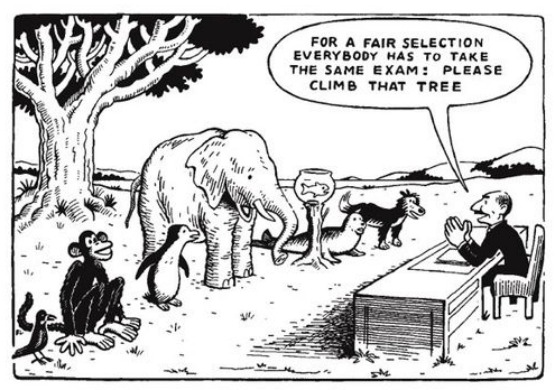All students have unique learning styles that make them different from one another. Students who have been identified with specific learning differences are legally entitled to receive a set of accomodations in their general education classes to aid in their learning experience. Catering to the different learning styles in a classroom of over 30 students can seem like a daunting task for a general education teacher. As a result, general education teachers implicitly give up students with learning differences to the education specialists, expecting them to provide accommodations or re-teach. The fact is that it is both the education specialists’ and general educators’ responsibility to provide the legally required accommodations for students with specific learning differences.
The best way a general education teacher can provide accomodations is by incorporating accommodations for learning differences in their lesson. This means that the accommodations are not only given to students who are legally entitled to receive them, instead they are given to the class a whole. By incorporating accomodations in general education lesson plans, all students receive a special education, as they are very well entitled to receive. In my last article, I wrote about the importance of seating. In this article, I am sharing ideas on how to incorporate accommodations for students with auditory processing difference, visual processing difference, and attention difference (also known as impulse control) in general education lesson plans.
According to The National Institute on Deafness and Other Communication Disorders,auditory processing difference is “a condition in which people have trouble making sense of the sounds around them.” Although this definition is very basic, it captures the essence of this
 learning difference – the difficulty of discriminating between competing sounds in the classroom. One accomodation that can be implemented in a general education lesson is the use of step cards. Step cards are used as a form of individual student agendas where students check off assignments as they are completed. Step cards are useful to keep students who might have trouble hearing directions up to speed with the rest of the class. Step cards should be printed and given to students so that they can check-off items as they make progress. If you are like many teachers, swamped with too many documents to print already, think about dedicating a space on your whiteboard where you write a whole class step card, and check off steps as the class completes them.
learning difference – the difficulty of discriminating between competing sounds in the classroom. One accomodation that can be implemented in a general education lesson is the use of step cards. Step cards are used as a form of individual student agendas where students check off assignments as they are completed. Step cards are useful to keep students who might have trouble hearing directions up to speed with the rest of the class. Step cards should be printed and given to students so that they can check-off items as they make progress. If you are like many teachers, swamped with too many documents to print already, think about dedicating a space on your whiteboard where you write a whole class step card, and check off steps as the class completes them.
According to understood.org visual spatial processing difference is “the ability to tell where objects are in space. . .[the ability to] tell how far objects are from you and from each other.” Students with visual spatial processing difference have a difficult time distinguishing between letters (“what is the difference between a ‘v’ and a ‘u’?” they might ask). One accommodation consists on reformatting articles. Serif, 12 point fonts with 1.5 to 2 spacing between lines are helpful when reading an article. Numbering paragraphs can be a world of difference for a student who double and triple reads sentences without realizing it, and removing ads can make reading less distracting. You can take a look at an example of a formatted article from the NY Times.
Finally, according to understood.org, Attention difference comes in many forms, but the basic forms manifest themselves as ADD and ADHD. According to educational consultant, Rayma Griffin, “The biggest difference between ADD and ADHD is that kids with ADHD are hyperactive.” An accommodation a teacher can provide in their general education lesson is a scheduled ‘brain break.’ These breaks will normally consist of a 3 to 5 minute time when students have the opportunity to get up from their seats and stretch. They will not be missing content because the break will be scheduled in, so the this can be an opportunity when everyone, including the teacher, can take a break from the lesson.
These are three, very simple accommodations that can be implemented by general education teachers for entire classes in order facilitate the learning experience for everyone. If you are interested in learning about more strategies and accommodations, visit ldaamerica.org.
Robel Espino
Latest posts by Robel Espino (see all)
- Parte 2, Explorando las Ideas de Jeffrey Duncan-Andrade: La Política y la Economía del Fracaso - December 18, 2019
- Part 2, Exploring Jeffrey Duncan-Andrade’s Ideas:The Politics and Economics of Failure - December 16, 2019
- Explorando Las Ideas de Jeffrey Duncan-Andrade, Parte 1: El Sistema de Educación Urbana, No Está Fallando - December 3, 2019
- Exploring Jeffrey Duncan-Andrade’s Ideas, Part 1: The Urban Education System Is Not Failing - November 26, 2019
- Estudio Sugiere Que las Lecturas en el Aula No Son Muy Efectivas, Pero Mis Alumnos y Yo las Amamos - November 22, 2019

